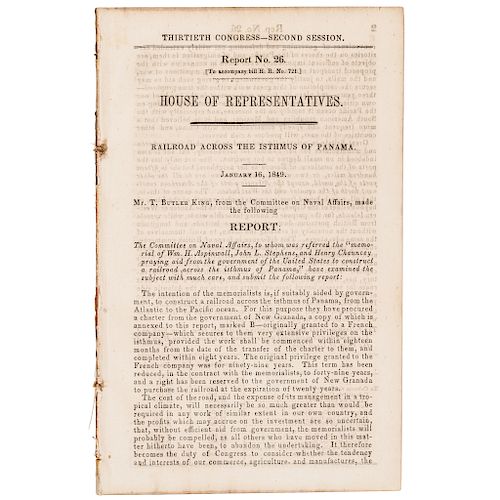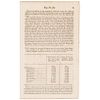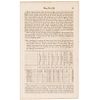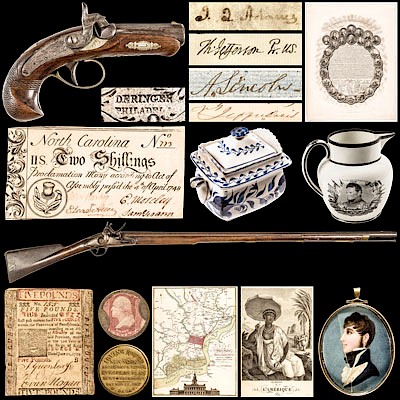1849 Railroad Across the Isthmus of Panama, 30th Congress Naval Affairs Imprint
Lot 221
Categories
Estimate:
$200 - $300
Absentee vs Live bid
Two ways to bid:
- Leave a max absentee bid and the platform will bid on your behalf up to your maximum bid during the live auction.
- Bid live during the auction and your bids will be submitted real-time to the auctioneer.
Bid Increments
| Price | Bid Increment |
|---|---|
| $0 | $10 |
| $200 | $20 |
| $300 | $25 |
| $500 | $50 |
| $1,000 | $100 |
| $2,000 | $200 |
| $3,000 | $250 |
| $5,000 | $500 |
| $10,000 | $1,000 |
| $20,000 | $2,000 |
| $30,000 | $2,500 |
| $50,000 | $5,000 |
| $100,000 | $10,000 |
| $200,000 | $20,000 |
| $300,000 | $25,000 |
| $500,000 | $50,000 |
About Auction
By Early American History Auctions
Oct 19, 2019
Set Reminder
2019-10-19 12:00:00
2019-10-19 12:00:00
America/New_York
Bidsquare
Bidsquare : Historic Autographs-Currency-Political-Americana-Militaria-Guns
https://www.bidsquare.com/auctions/early-american-history-auctions/historic-autographs-currency-political-americana-militaria-guns-4513
326 Lots of Rare, Historic Autographs, Americana, Civil War Era, George Washington, Abraham Lincoln, Black History, Revolutionary War Era, Colonial America, Federal Period, War of 1812, Colonial Currency, Indian Peace Medals & more... Early American History Auctions auctions@earlyamerican.com
326 Lots of Rare, Historic Autographs, Americana, Civil War Era, George Washington, Abraham Lincoln, Black History, Revolutionary War Era, Colonial America, Federal Period, War of 1812, Colonial Currency, Indian Peace Medals & more... Early American History Auctions auctions@earlyamerican.com
- Lot Description
Post-Revolutionary War to Civil War
1849 "Railroad Across the Isthmus of Panama" US Imprint
January 16, 1849-Dated, 30th Congress 2nd Session, Imprint titled, "Railroad Across the Isthmus of Panama." (Stared in 1850, First attempted Canal in 1881), Choice Very Fine.
This rare original Congressional Imprint measures about 5.5" x 9", and has 46 pages, disbound, clean and easily readable. It is noted as "Report No. 26 (To accompany bill H.R. No. 721.)". It is a report by "Mr. T. Butler King, from the Committee on Naval Affairs". A "memorial of Wm. H. Aspinwall, John L. Stephans, and Henry Chauncey parying aid from the government of the United States to construct a railroad across the isthmus of Panama, have examined the subject with much care, and submit the following report." This historic Imprint goes on to give the pros and cons for this request. Scarce.
The discovery of gold in California attracted a multitude of "Forty-niners" who, urged on by the true spirit of the pioneer and a cupidity that was dauntless, flocked to the Isthmus in such numbers that the need was infinitely increased for a regular line of steamships between the Atlantic and Pacific ports.
The changes that took place were sparked initially by, of all things, the United States Post Office! Some new way had to be found to carry the growing volume of mail from the East Coast to California, and the Panama route was logical.
Accordingly, the North American Congress hastened to authorize contracts for the establishment of two lines of mail steamships--one from New York and New Orleans to Panama, and the other to connect with this by the Isthmus of Panama to California and Oregon. Mr. William H. Aspinwall secured the line on the Pacific side and Mr. George Law the line on the Atlantic side. The ships in the Pacific helped to relieve the congestion on that side, but it was more than offset by the number of new arrivals at San Lorenzo, for of course in addition to mail, the ships carried passengers.
The tremendous bottleneck, both for mail and for people was that ghastly fifty-mile hike through the jungle. A railroad was the obvious answer.
William H. Aspinwall was a man of vision and in securing the contracts for the steamship line it was his plan in the beginning to build a railroad across the Isthmus. Together with his associates, John L. Stephens and Henry Chauncey, they entered into a contract for the construction of an "Iron Road across the Isthmus of Panama".
However, before the contract was ratified, the services of Mr. G. W. Hughes of the United States Topographical Corps were engaged and he, accompanied by a large party of engineers, came down from New York for the purpose of mapping and surveying and locating the road. Their report that a railroad across the Isthmus was a practical and feasible proposition corroborated Mr. Stephens' own opinion.
Mr. Aspinwall immediately returned to New York and conjointly with his partners, John L. Stephens and Mr. Henry M. Chauncey, incorporated under the name of Panama Railroad Company and a formal contract was entered into on April 15, 1850, with the Government of New Granada for the exclusive privilege of establishing "an iron Railroad between the two oceans across the Isthmus of Panama"
This contract was liberal in its terms and granted to this company the right of operating the road for a period of forty-nine years from the date of completion. It was stipulated that the construction should not occupy a longer period than six years. The engineers secured on the construction of the road were Col. G. W. Totten and John C. Trautwine, and under their capable guidance the work on this gigantic undertaking was begun in May, 1850.
- Shipping Info
-
Early American provides in-house worldwide shipping. Please contact us directly if you have questions about your specific shipping requirements.
-
- Buyer's Premium



 EUR
EUR CAD
CAD AUD
AUD GBP
GBP MXN
MXN HKD
HKD CNY
CNY MYR
MYR SEK
SEK SGD
SGD CHF
CHF THB
THB













